The Middle Miocene Microfacies, Cyclicity, and Depositional History: Implications on the Marmarica Formation at the Siwa Oasis, Western Desert (Egypt)
Abstract
1. Introduction
2. Materials and Methods
3. Geological Setting
4. Lithostratigraphy
5. Results
5.1. Lithostratigraphy
5.1.1. The Lower Member
5.1.2. The Middle Member
5.1.3. The Upper Member
5.2. Microfacies Analysis
5.2.1. Lime-Mudstone Microfacies (LM)
Dolomitic Lime-Mudstone Microfacies (DL)
Skeletal Lime-Mudstone Microfacies (SL)
5.2.2. Wackestone Microfacies
Intraclastic Wackstone Microfacies (IW)
Bryozoan Wackestone Microfacies (BW)
Foraminiferal Wackstone Microfacies (FW)
5.2.3. Packstone Microfacies Association
Foraminiferal Bryozoan Packstone Microfacies (FBP)
Glauconitic Molluscan Packstone Microfacies (GMP)
Molluscan Intraclastic Packstone Microfacies (MIP)
Pelletal Peloidal Skeletal Packstone Microfacies (PPSP)
5.2.4. Claystone Lithofacies
5.2.5. Dolostone
Unimodal, Fine-Crystalline Planar-e (Euhedral)
Polymodal, Fine-Crystalline Planar-s (Subhedral)
5.3. The Cyclicity
5.3.1. The Gradual Cycles
The Gradual Cycle Type 1 (G1)
The Gradual Cycle Type 2 (G2)
The Gradual Cycle Type 3 (G3)
The Gradual Cycle Type 4 (G4)
5.3.2. The Non-Gradual Cycles
The Non-Gradual Cycle Type 1 (NG1)
The Non-Gradual Cycle Type 2 (NG2)
The Non-Gradual Cycle Type 3 (NG3)
The Non-Gradual Cycle Type 4 (NG4)
The Non-Gradual Cycle Type 5 (NG5)
The Non-Gradual Cycle Type 6 (NG6)
6. Discussion
7. Conclusions
Author Contributions
Funding
Data Availability Statement
Acknowledgments
Conflicts of Interest
References
- Frigola, A.; Prange, M.; Schulz, M. Boundary Conditions for the Middle Miocene Climate Transition (MMCT v1.0). Geosci. Model Dev. 2018, 11, 1607–1626. [Google Scholar] [CrossRef]
- Pound, M.J.; Haywood, A.M.; Salzmann, U.; Riding, J.B. Global Vegetation Dynamics and Latitudinal Temperature Gradients during the Mid to Late Miocene (15.97–5.33 Ma). Earth-Sci. Rev. 2012, 112, 1–22. [Google Scholar] [CrossRef]
- Billups, K.; Schrag, D.P. Paleotemperatures and Ice Volume of the Past 27 Myr Revisited with Paired Mg/Ca and 18O/16O Measurements on Benthic Foraminifera. Paleoceanography 2002, 17, 3-1–3-11. [Google Scholar] [CrossRef]
- Shevenell, A.E.; Kennett, J.P.; Lea, D.W. Middle Miocene Ice Sheet Dynamics, Deep-Sea Temperatures, and Carbon Cycling: A Southern Ocean Perspective. Geochem. Geophys. Geosystems 2008, 9, Q02006. [Google Scholar] [CrossRef]
- Lear, C.H.; Mawbey, E.M.; Rosenthal, Y. Cenozoic Benthic Foraminiferal Mg/Ca and Li/Ca Records: Toward Unlocking Temperatures and Saturation States: Ocean temperatures and saturation state. Paleoceanography 2010, 25, PA4215. [Google Scholar] [CrossRef]
- Haq, B.U.; Hardenbol, J.; Vail, P.R. Chronology of Fluctuating Sea Levels Since the Triassic. Science 1987, 235, 1156–1167. [Google Scholar] [CrossRef] [PubMed]
- Kominz, M.A.; Browning, J.V.; Miller, K.G.; Sugarman, P.J.; Mizintseva, S.; Scotese, C.R. Late Cretaceous to Miocene Sea-level Estimates from the New Jersey and Delaware Coastal Plain Coreholes: An Error Analysis. Basin Res. 2008, 20, 211–226. [Google Scholar] [CrossRef]
- John, C.M.; Karner, G.D.; Browning, E.; Leckie, R.M.; Mateo, Z.; Carson, B.; Lowery, C. Timing and Magnitude of Miocene Eustasy Derived from the Mixed Siliciclastic-Carbonate Stratigraphic Record of the Northeastern Australian Margin. Earth Planet. Sci. Lett. 2011, 304, 455–467. [Google Scholar] [CrossRef]
- Buchbinder, B. Miocene Carbonates of the Eastern Mediterranean, the Red Sea and the Mesopotamian Basin: Geodynamic and Eustatic Controls; The Society for Sedimentary Geology: Tulsa, OK, USA, 1996. [Google Scholar]
- Piller, W.E.; Harzhauser, M.; Mandic, O. Miocene Central Paratethys Stratigraphy–Current Status and Future Directions. Stratigraphy 2007, 4, 151–168. [Google Scholar] [CrossRef]
- Mutti, M.; Piller, W.; Betzler, C. (Eds.) Miocene Carbonate Systems: An Introduction. Oligocene–Miocene Carbonate Systems, 1st ed.; The International Accreditation Service: Geneva, Switzerland, 2010; Volume 42. [Google Scholar]
- Said, R. The Geology of Egypt: Balkema; Brookfield: Rotterdam, The Netherlands, 1990; Volume 734. [Google Scholar]
- Abdulsamad, E.O.; Bu-Argoub, F.M.; Tmalla, A.F.A. A Stratigraphic Review of the Eocene to Miocene Rock Units in the al Jabal al Akhdar, NE Libya. Mar. Pet. Geol. 2009, 26, 1228–1239. [Google Scholar] [CrossRef]
- Gindy, A.R.; El Askary, M.A. Stratigraphy, Structure, and Origin of Siwa Depression, Western Desert of Egypt. AAPG Bull. 1969, 53, 603–625. [Google Scholar]
- Tamish, M.O.; Holail, H.M.; El-Askary, M.A.; Sadek, A. Lithostratigraphy, Facies Analysis and Depositional Environments of the Middle Miocene Carbonate Rocks, Northwestern Desert, Egypt. Bull. Fac. Sci. Alex. Univ. 1996, 1, 251–264. [Google Scholar]
- Abdel-Fattah, Z.A.; Kora, M.A.; Ayyad, S.N. Facies Architecture and Depositional Development of Middle Miocene Carbonate Strata at Siwa Oasis, Northwestern Egypt. Facies 2013, 59, 505–528. [Google Scholar] [CrossRef]
- Anan, T.; Reda, A.; El Belasy, A.; El-Shahat, A. Facies Analysis and Sequence Stratigraphy of the Middle Miocene Marmarica Formation at Siwa Area, North Western Desert, Egypt. Geol. J. 2022, 57, 2749–2769. [Google Scholar] [CrossRef]
- Gindi, A.; Abd-Alla, M.A. Stable Isotopes and Microfacies of the Middle Miocene Marmarica Formation, North Western Desert, Egypt. Egypt. J. Geol 2000, 44, 109–125. [Google Scholar]
- Farouk, S.; Khalifa, M.A. Facies Tracts and Sequence Development of the Middle Eocene–Middle Miocene Successions of the Southwestern Qattara Depression, Northern Western Desert, Egypt. Palaontol. Stratigr. Fazies 2010, 18, 195–215. [Google Scholar]
- Said, R. The Geology of Egypt; Elsevier: Amsterdam, The Netherlands, 1962; Volume 377. [Google Scholar]
- Hantar, G. North Western Desert. In The Geology of Egypt; Balkema, A.A., Ed.; Brookfield: Rotterdam, The Netherlands, 1990; pp. 293–319. [Google Scholar]
- Issawi, B.; Francis, M.H.; Youssef, E.A.A.; Osman, R.A. The Phanerozoic Geology of Egypt: A Geodynamic Approach: Special Publication, 81; Ministry of Petroleum: Cairo, Egypt, 2009. [Google Scholar]
- Marzouk, I. Rock Stratigraphy and Oil Potentialities of the Oligocene and Miocene in the Western Desert of Egypt. In Proceedings of the 7th Arab Petroleum Congress, Kuwait, 16–22 March 1970; Volume 54, pp. 1–37. [Google Scholar]
- Schlumberger Middle East. Geology of Egypt; Schlumberger Middle East: Cairo, Egypt, 1984; pp. 1–64. [Google Scholar]
- Ouda, K. Biostratigraphy, Paleoecology and Paleogeography of the Middle and Late Tertiary Deposits of the Northern Western Desert, Egypt. NEUES Jahrb. Geol. PALAONTOLOGIE Abh. 1998, 207, 311–394. [Google Scholar] [CrossRef]
- Dunham, R.J. Classification of Carbonate Rocks According to Depositional Textures. In Classification of Carbonate Rocks—A Symposium; AAPG: Tulsa, OK, USA, 1962; Volume 38, pp. 108–121. [Google Scholar]
- Embry, A.F.; Klovan, J.E. A Late Devonian Reef Tract on Northeastern Banks Island, NWT. Bull. Can. Pet. Geol. 1971, 19, 730–781. [Google Scholar]
- Coward, M.P.; Ries, A.C. Tectonic Development of North African Basins. Geol. Soc. Lond. Spec. Publ. 2003, 207, 61–83. [Google Scholar] [CrossRef]
- Guiraud, R.; Bosworth, W.; Thierry, J.; Delplanque, A. Phanerozoic Geological Evolution of Northern and Central Africa: An Overview. J. Afr. Earth Sci. 2005, 43, 83–143. [Google Scholar] [CrossRef]
- Rosendahl, B.R.; Kilembe, E.; Kaczmarick, K. Comparison of the Tanganyika, Malawi, Rukwa and Turkana Rift Zones from Analyses of Seismic Reflection Data. Tectonophysics 1992, 213, 235–256. [Google Scholar] [CrossRef]
- Holail, H.; Tamish, M.; El-Askary, M.; Sadek, A. Geochemistry and Diagenesis of Middle Miocene Carbonate Rocks, Northern Western Desert, Egypt. Neues Jahrb. Geol. Paläontol.-Monatsh. 1997, 191–212. [Google Scholar] [CrossRef]
- El-Shazly, S.H.; Abdel-Hamid, M. Contribution to the Middle Miocene Megafossils from Siwa Oasis, Western Desert, Egypt. Egypt. J. Paleontol. 2001, 1, 263–297. [Google Scholar]
- El-Sabbagh, A.M.; El Hedeny, M.M. A Shell Concentration of the Middle Miocene Crassostrea Gryphoides (Schlotheim, 1813) from Siwa Oasis, Western Desert, Egypt. J. Afr. Earth Sci. 2016, 120, 1–11. [Google Scholar] [CrossRef]
- El-Sabbagh, A.; El-Hedeny, M.; Al Farraj, S. Thalassinoides in the Middle Miocene Succession at Siwa Oasis, Northwestern Egypt. Proc. Geol. Assoc. 2017, 128, 222–233. [Google Scholar] [CrossRef]
- Flügel, E. Microfacies of Carbonate Rocks: Analysis, Interpretation and Application; Springer: Berlin/Heidelberg, Germany; New York, NY, USA, 2004; p. 976. [Google Scholar]
- Gregg, J.M.; Sibley, D.F. Epigenetic Dolomitization and the Origin of Xenotopic Dolomite Texture. J. Sediment. Res. 1984, 54, 908–931. [Google Scholar]
- Gregg, J.M. Origins of Dolomite in the Offshore Facies of the Bonneterre Formation (Cambrian), Southeast Missouri. In Sedimentology and Geochemistry of Dolostones; Shukla, V., Baker, P.A., Eds.; The Society for Sedimentary Geology: Tulsa, OK, USA, 1988; Volume 43, ISBN 978-1-56576-169-8. [Google Scholar]
- Wright, W.R. Dolomitization, Fluid-Flow and Mineralization of the Lower Carboniferous Rocks of the Irish Midlands and Dublin Basin Regions. Ph.D. Thesis, University College Dublin, Dublin, Ireland, 2001. [Google Scholar]
- Fisher, A.G. The Lofer Cyclothems of the Alpine Triassic. Bull. Kans. Geol. Surv. 1964, 169, 107–149. [Google Scholar]
- Grotzinger, J.P. Cyclicity and Paleoenvironmental Dynamics, Rocknest Platform, Northwest Canada. Geol. Soc. Am. Bull. 1986, 97, 1208–1231. [Google Scholar] [CrossRef]
- Goldhammer, R.K.; Dunn, P.A.; Hardie, L.A. High Frequency Glacio-Eustatic Sealevel Oscillations with Milankovitch Characteristics Recorded in Middle Triassic Platform Carbonates in Northern Italy. Am. J. Sci. 1987, 287, 853–892. [Google Scholar] [CrossRef]
- Goldhammer, R.K.; Dunn, P.A.; Hardie, L.A. Depositional Cycles, Composite Sea-Level Changes, Cycle Stacking Patterns, and the Hierarchy of Stratigraphic Forcing: Examples from Alpine Triassic Platform Carbonates. Geol. Soc. Am. Bull. 1990, 102, 535–562. [Google Scholar] [CrossRef]
- Strasser, A. Shallowing-upward Sequences in Purbeckian Peritidal Carbonates (Lowermost Cretaceous, Swiss and French Jura Mountains). Sedimentology 1988, 35, 369–383. [Google Scholar] [CrossRef]
- Haas, J. A Basic Model for Lofer Cycles. In Cycles and Events in Stratigraphy; Springer: Berlin/Heidelberg, Germany, 1991; pp. 722–732. [Google Scholar]
- Osleger, D. Subtidal Carbonate Cycles: Implications for Allocyclic vs. Autocyclic Controls. Geology 1991, 19, 917–920. [Google Scholar] [CrossRef]
- Satterley, A.K. Cyclic Carbonate Sedimentation in the Upper Triassic Dachstein Limestone, Austria; the Role of Patterns of Sediment Supply and Tectonics in a Platform-Reef-Basin System. J. Sediment. Res. 1996, 66, 307–323. [Google Scholar]
- Satterley, A.K. The Interpretation of Cyclic Successions of the Middle and Upper Triassic of the Northern and Southern Alps. Earth-Sci. Rev. 1996, 40, 181–207. [Google Scholar] [CrossRef]
- Khalifa, M.A. Depositional Cycles in Relation to Sea Level Changes, Case Studies from Egypt and Saudi Arabia. Egypt. J. Geol. 1996, 40, 141–171. [Google Scholar]
- Enos, P.; Samankassou, E. Lofer Cyclothems Revisited (Late Triassic, Northern Alps, Austria). Facies 1998, 38, 207–227. [Google Scholar] [CrossRef]
- Haas, J.; Lobitzer, H.; Monostori, M. Characteristics of the Lofer Cyclicity in the Type Locality of the Dachstein Limestone (Dachstein Plateau, Austria). Facies 2007, 53, 113–126. [Google Scholar] [CrossRef]
- Gindy, A.R. The Relative Diagenetic Order of Preservation of Skeletal Structures in Fossil Debris of a Miocene Coquina near Salûm, Egypt. Neues Jahrb. Geol. Paläontol. Monatsh. 1987, 1, 27–42. [Google Scholar] [CrossRef]
- El-Shahat, A. Middle Miocene Carbonates from the Northern Plateau of the Western Desert (Egypt): Petrography and Geochemistry. Facies 1993, 28, 67–76. [Google Scholar] [CrossRef]
- Gameil, M.; Sadek, S. Stratigraphy, Megafossil Content and Microfacies Analysis of the Middle Miocene Rocks, East Matruh, Northwestern Egypt. 2nd Inter Conf Geo-Resources in the Middle East and North Africa (Germena). Cairo Univ. 2007, 2, 3–28. [Google Scholar]
- Khalifa, M.; Al-Kahtany, K.; Farouk, S.; El-Sorogy, A.S.; Al Qahtani, A. Microfacies Architecture and Depositional History of the Upper Jurassic (Kimmeridgian) Jubaila Formation in Central Saudi Arabia. J. Afr. Earth Sci. 2021, 174, 104076. [Google Scholar] [CrossRef]
- Ali, C.A.; Mohamed, K.R. Microfacies and Diagenesis in the Setul Limestone in Langkawi and Perlis. Bull. Geol. Soc. Malays. 2013, 59, 59–66. [Google Scholar] [CrossRef]
- Wilson, J.L. The Lower Carboniferous Waulsortian Facies. In Carbonate Facies in Geologic History; Springer: New York, NY, USA, 1975; pp. 148–168. ISBN 978-0-387-90343-9. [Google Scholar]
- Lee, Y.I.; Kim, J.C. Storm-influenced Siliciclastic and Carbonate Ramp Deposits, the Lower Ordovician Dumugol Formation, South Korea. Sedimentology 1992, 39, 951–969. [Google Scholar] [CrossRef]
- Hiscott, R.N. Tidal Deposits of the Lower Cambrian Random Formation, Eastern Newfoundland: Facies and Paleoenvironments. Can. J. Earth Sci. 1982, 19, 2028–2042. [Google Scholar] [CrossRef]
- Smith, S.A.; Hiscott, R.N. Latest Precambrian to Early Cambrian Basin Evolution, Fortune Bay, Newfoundland: Fault-Bounded Basin to Platform. Can. J. Earth Sci. 1984, 21, 1379–1392. [Google Scholar] [CrossRef]
- Odin, G.S.; Fullagar, P.D. Chapter C4 Geological Significance of the Glaucony Facies. In Developments in Sedimentology; Elsevier: Amsterdam, The Netherlands, 1988; Volume 45, pp. 295–332. [Google Scholar]
- Hesse, R. Silica Diagenesis: Origin of Inorganic and Replacement Cherts. Earth-Sci. Rev. 1989, 26, 253–284. [Google Scholar] [CrossRef]
- Thambunya, S.; Pisutha-Arnond, V.; Khantaprab, C. Depositional Environments of Permian Rocks of the Khao Khad Formation in Central Thailand. ScienceAsia 2007, 33, 371–381. [Google Scholar] [CrossRef]
- Longman, M.W. Carbonate Diagenetic Textures from Nearsurface Diagenetic Environments. AAPG Bull. 1980, 64, 461–487. [Google Scholar]
- Whalen, M.T. Depositional History of an Upper Triassic Drowned Carbonate Platform Sequence: Wallowa Terrane, Oregon and Idaho. Geol. Soc. Am. Bull. 1988, 100, 1097–1110. [Google Scholar] [CrossRef]
- Ziko, A.; El-Sorogy, A.S.; Zalat, A.; Eweda, S.; Saber, N. Middle Miocene Bryozoa from Siwa Oasis, Western Desert, Egypt. In Proceedings of the 5th International Conference of Geology of the Arab World: Cairo University, Cairo, Egypt, 21–24 February 2000; pp. 1465–1496. [Google Scholar]
- Hallock, P.; Glenn, E.C. Larger Foraminifera: A Tool for Paleoenvironmental Analysis of Cenozoic Carbonate Depositional Facies. Palaios 1986, 1, 55–64. [Google Scholar] [CrossRef]
- Kumar, P.; Saraswati, P.K.; Banerjee, S. Early Miocene Shell Concentration in the Mixed Carbonate-Siliciclastic System of Kutch and Their Distribution in Sequence Stratigraphic Framework. J. Geol. Soc. India 2009, 74, 432–444. [Google Scholar] [CrossRef]
- Heckel, P.H. Recognition of Ancient Shallow Marine Environments. In Recognition of Ancient Sedimentary Environments; Rigby, J.K., Hamblin, W.K., Eds.; The Society for Sedimentary Geology: Tulsa, OK, USA, 1972; Volume 16, pp. 226–286. ISBN 978-1-56576-146-9. [Google Scholar]
- Kulm, L.D.; Roush, R.C.; Harlett, J.C.; Neudeck, R.H.; Chambers, D.M.; Runge, E.J. Oregon Continental Shelf Sedimentation: Interrelationships of Facies Distribution and Sedimentary Processes. J. Geol. 1975, 83, 145–175. [Google Scholar] [CrossRef]
- Ziegler, B. Ammoniten-Ökologie am Beispiel des Oberjura. Geol. Rundsch. 1967, 56, 439–464. [Google Scholar] [CrossRef]
- Harris, M.K.; Thayer, P.A.; Amidon, M.B. Sedimentology and Depositional Environments of Middle Eocene Terrigenous-Carbonate Strata, Southeastern Atlantic Coastal Plain, USA. Sediment. Geol. 1997, 108, 141–161. [Google Scholar] [CrossRef]
- Amorosi, A. Detecting Compositional, Spatial, and Temporal Attributes of Glaucony: A Tool for Provenance Research. Sediment. Geol. 1997, 109, 135–153. [Google Scholar] [CrossRef]
- McRae, S.G. Glauconite. Earth-Sci. Rev. 1972, 8, 397–440. [Google Scholar] [CrossRef]
- Huggett, J.M. Scanning Electron Microscope and X-ray Diffraction Investigations of Mudrock Fabrics, Textures and Mineralogy. Scan. Microsc. 1989, 3, 12. [Google Scholar]
- Snedden, J.W.; Kersey, D.G. Origin of San Miguel Lignite Deposit and Associated Lithofacies, Jackson Group, South Texas. AAPG Bull. 1981, 65, 1099–1109. [Google Scholar]
- Haldar, S.K. Introduction to Mineralogy and Petrology; Elsevier: Amsterdam, The Netherlands, 2020. [Google Scholar]
- Brett, C.E. Sedimentology, Facies and Depositional Environments of the Rochester Shale (Silurian; Wenlockian) in Western New York and Ontario. J. Sediment. Petrol. 1983, 53, 947–971. [Google Scholar]
- Morrow, D.W. Diagenesis 1. Dolomite-Part 1: The Chemistry of Dolomitization and Dolomite Precipitation. Geosci. Can. 1982, 9, 5–13. [Google Scholar]
- Al-Aasm, I.S.; Packard, J.J. Stabilization of Early-Formed Dolomite: A Tale of Divergence from Two Mississippian Dolomites. Sediment. Geol. 2000, 131, 97–108. [Google Scholar] [CrossRef]
- Ginsburg, R.N. Landward Movement of Carbonate Mud: New Model for Regressive Cycles in Carbonates. AAPG Bull. 1971, 55, 340. [Google Scholar]
- James, N.P. Shallowing-Upward Sequences in Carbon-Ates. Facies Models 1984, 1, 213–228. [Google Scholar]
- Hardie, L.A. Carbonate Depositional. Environments, Modern and Ancient: Part 3: Tidal Fiats. Colo. Sch. Mines Q. 1986, 81, 1–74. [Google Scholar]
- Koerschner, W.F.; Read, J.F. Field and Modelling Studies of Cambrian Carbonate Cycles, Virginia, Appalachians. J. Sediment. Res. 1989, 59, 654–687. [Google Scholar] [CrossRef]
- Elrick, M.; Read, J.F. Cyclic Ramp-to-Basin Carbonate Deposits, Lower Mississippian, Wyoming and Montana; a Combined Field and Computer Modeling Study. J. Sediment. Petrol. 1991, 61, 1194–1224. [Google Scholar]
- Brandano, M.; Frezza, V.; Tomassetti, L.; Pedley, M.; Matteucci, R. Facies Analysis and Palaeoenvironmental Interpretation of the Late Oligocene Attard Member (Lower Coralline Limestone Formation), Malta. Sedimentology 2009, 56, 1138–1158. [Google Scholar] [CrossRef]
- Read, J.F. Carbonate Platform Facies Models. AAPG Bull. 1985, 69, 1–21. [Google Scholar]
- Tucker, M.A. Sedimentary Petrology, 3rd ed.; Blackwell Publishing: Oxford, UK, 2008. [Google Scholar]
- Adachi, N.; Ezaki, Y.; Liu, J. The Fabrics and Origins of Peloids Immediately after the End-Permian Extinction, Guizhou Province, South China. Sediment. Geol. 2004, 164, 161–178. [Google Scholar] [CrossRef]
- Tucker, M.E.; Wright, V.P. Carbonate Sedimentology; Blackwell Scientific Publication: Hoboken, NJ, USA, 1990. [Google Scholar]
- Flügel, E. Microfacies of Carbonate Rocks: Analysis, Interpretation and Application, 2nd ed.; Springer: Berlin/Heidelberg, Germany, 2010; ISBN 978-3-642-03795-5. [Google Scholar]
- Geel, T. Recognition of Stratigraphic Sequences in Carbonate Platform and Slope Deposits: Empirical Models Based on Microfacies Analysis of Palaeogene Deposits in Southeastern Spain. Palaeogeogr. Palaeoclimatol. Palaeoecol. 2000, 155, 211–238. [Google Scholar] [CrossRef]
- Pomar, L.; Brandano, M.; Westphal, H. Environmental Factors Influencing Skeletal Grain Sediment Associations: A Critical Review of Miocene Examples from the Western Mediterranean. Sedimentology 2004, 51, 627–651. [Google Scholar] [CrossRef]
- Pomar, L. Types of Carbonate Platforms: A Genetic Approach. Basin Res. 2001, 13, 313–334. [Google Scholar] [CrossRef]
- Khalifa, M.A. Lithofacies, Diagenesis and Cyclicity of the ‘Lower Member’ of the Khuff Formation (Late Permian), Al Qasim Province, Saudi Arabia. J. Asian Earth Sci. 2005, 25, 719–734. [Google Scholar] [CrossRef]

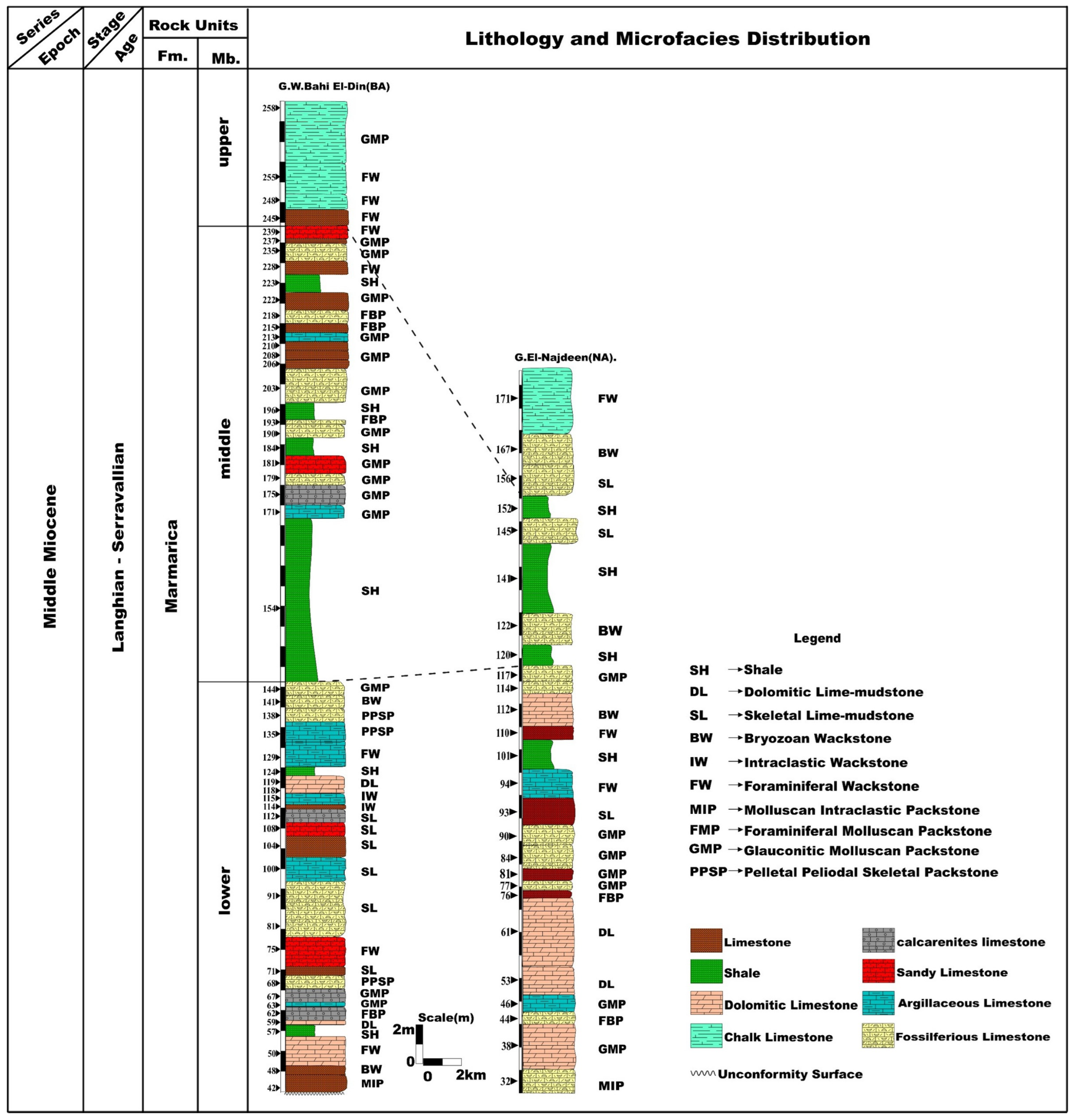
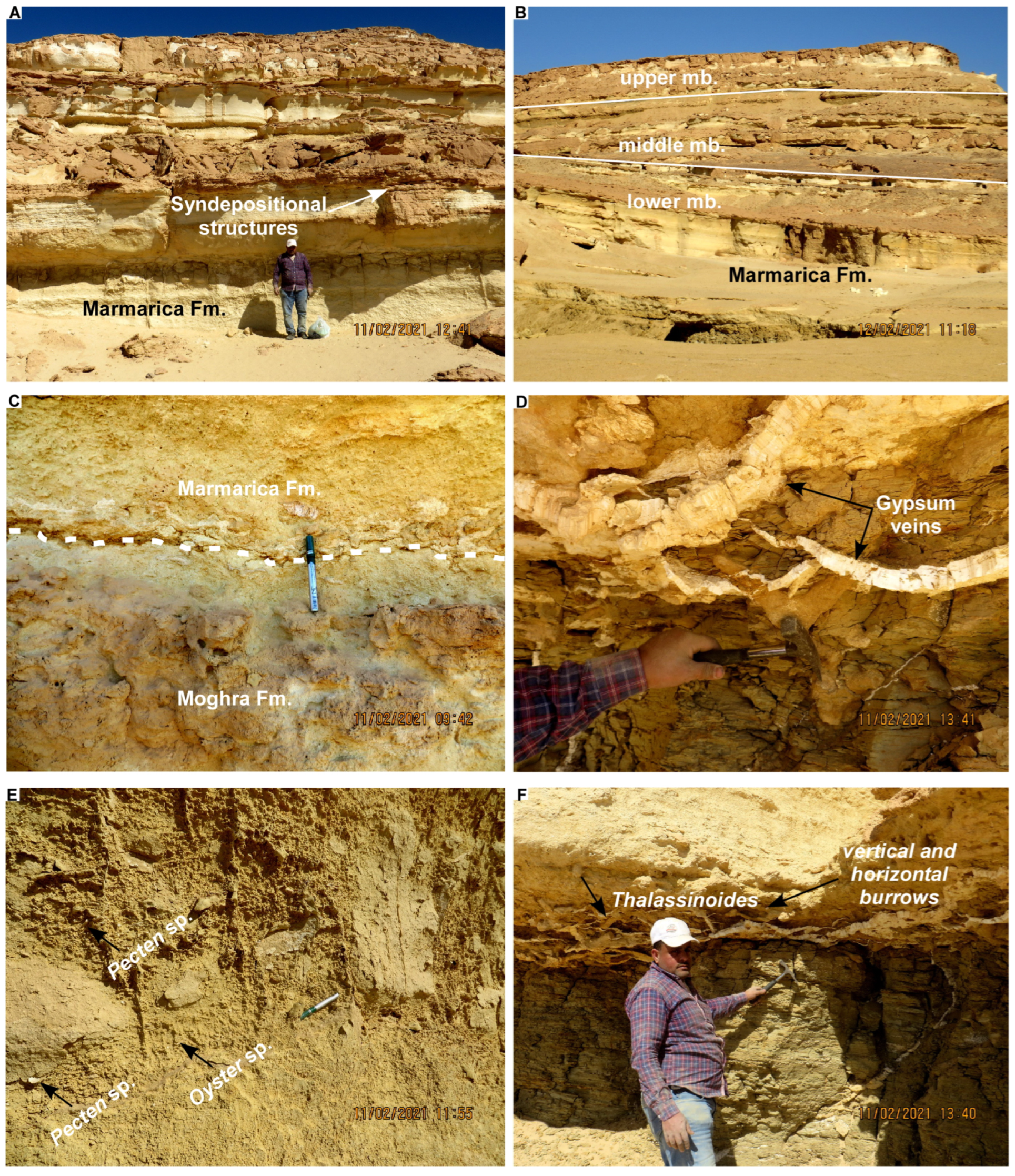

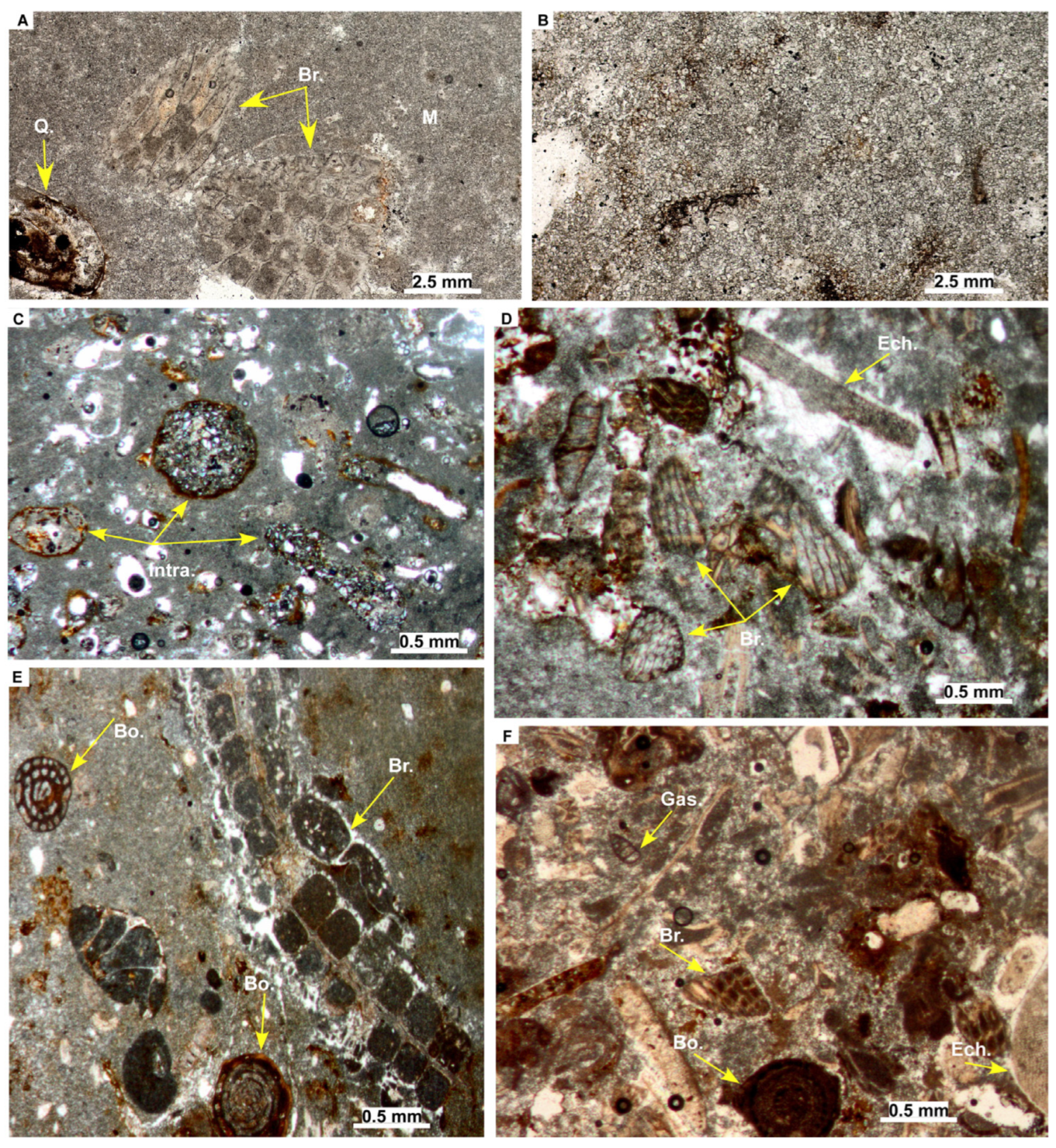
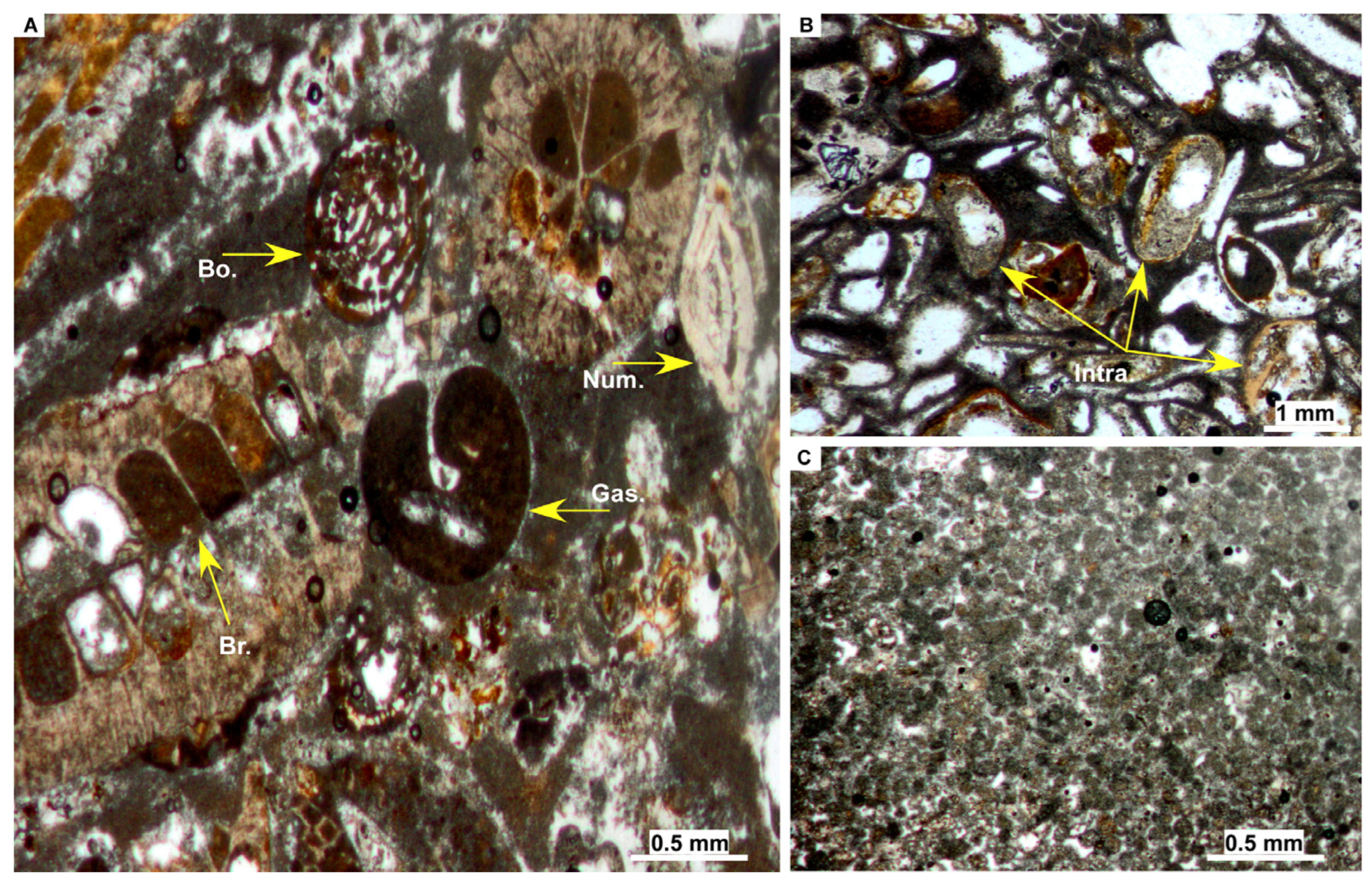
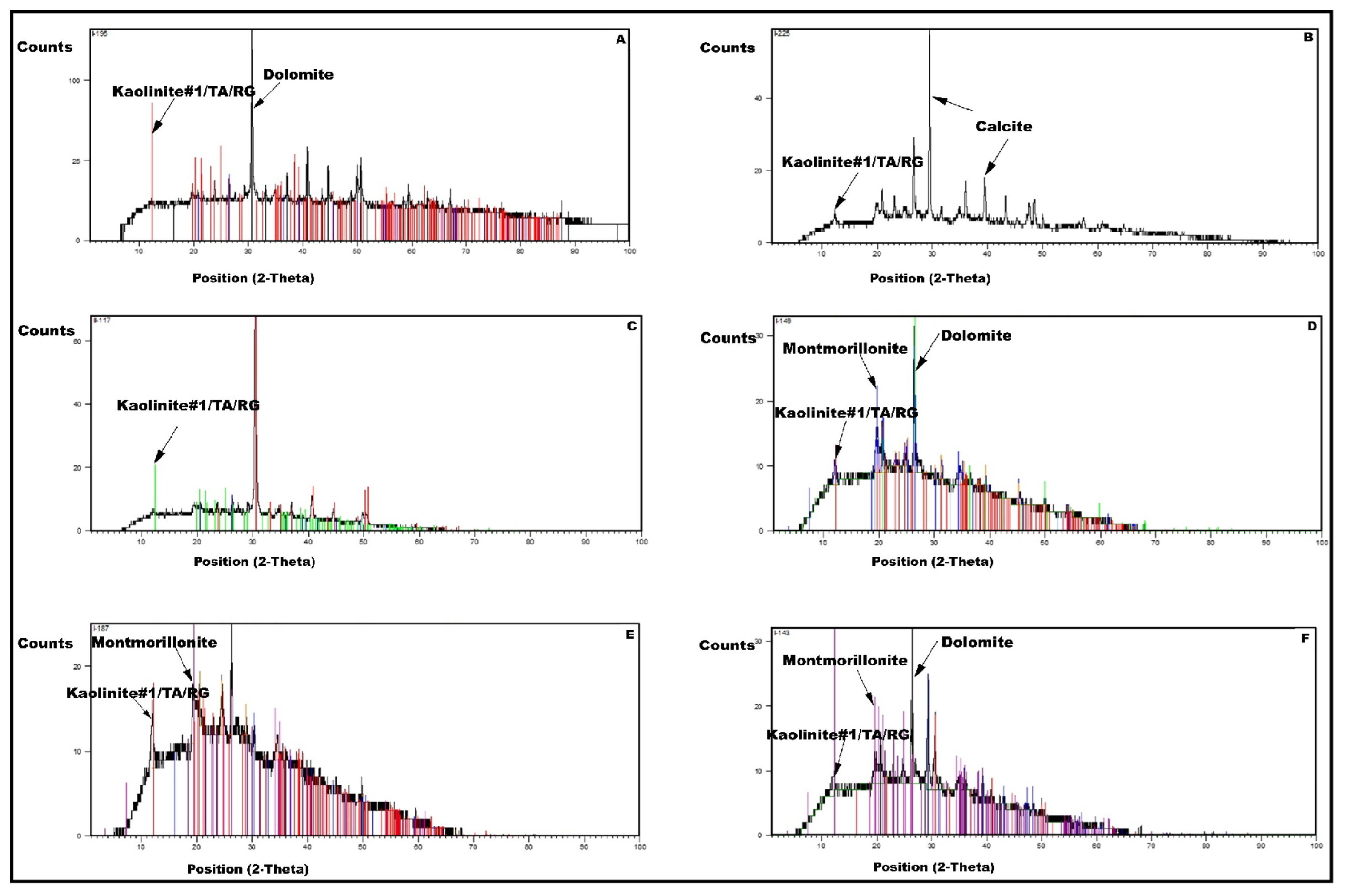

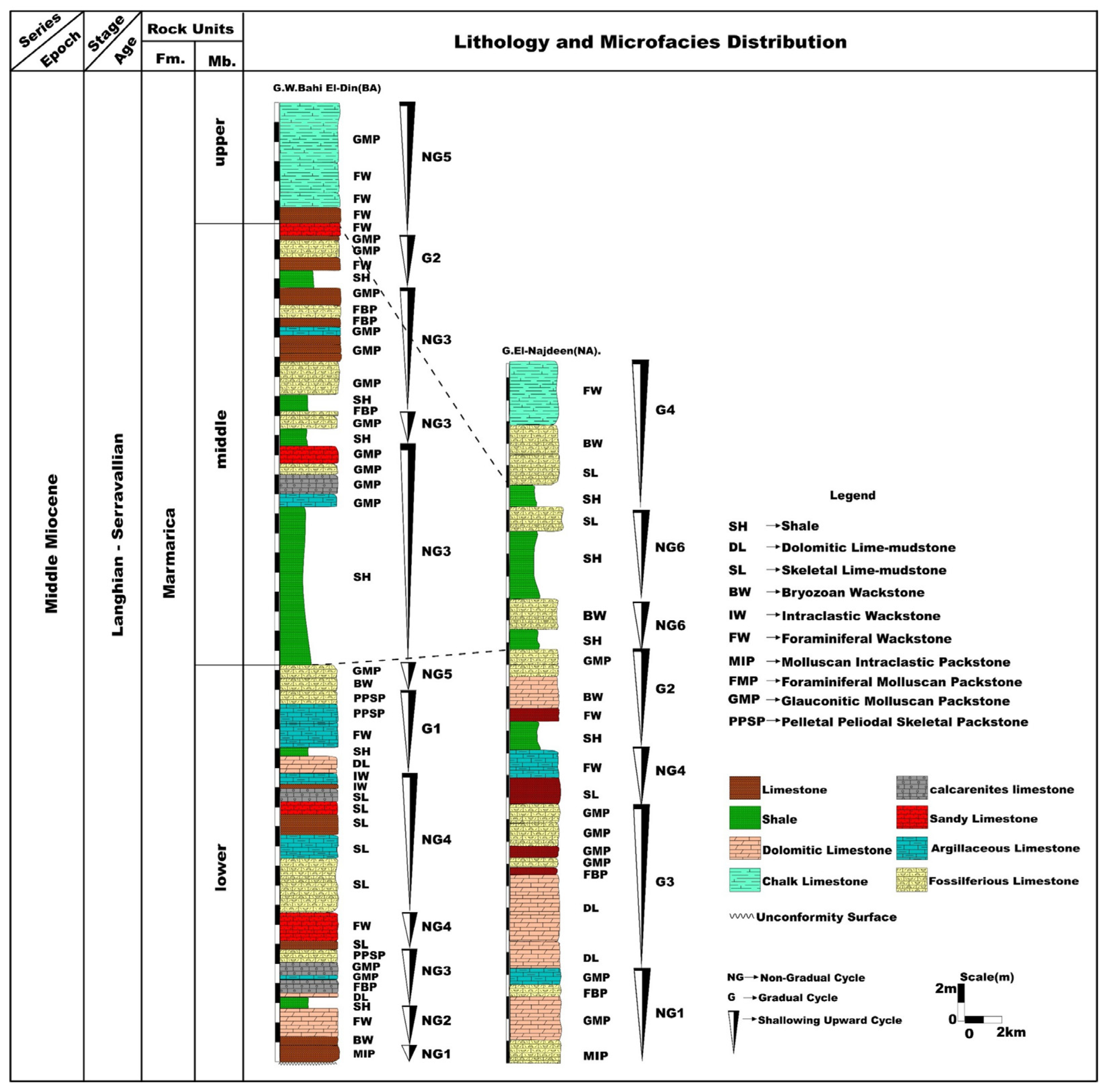
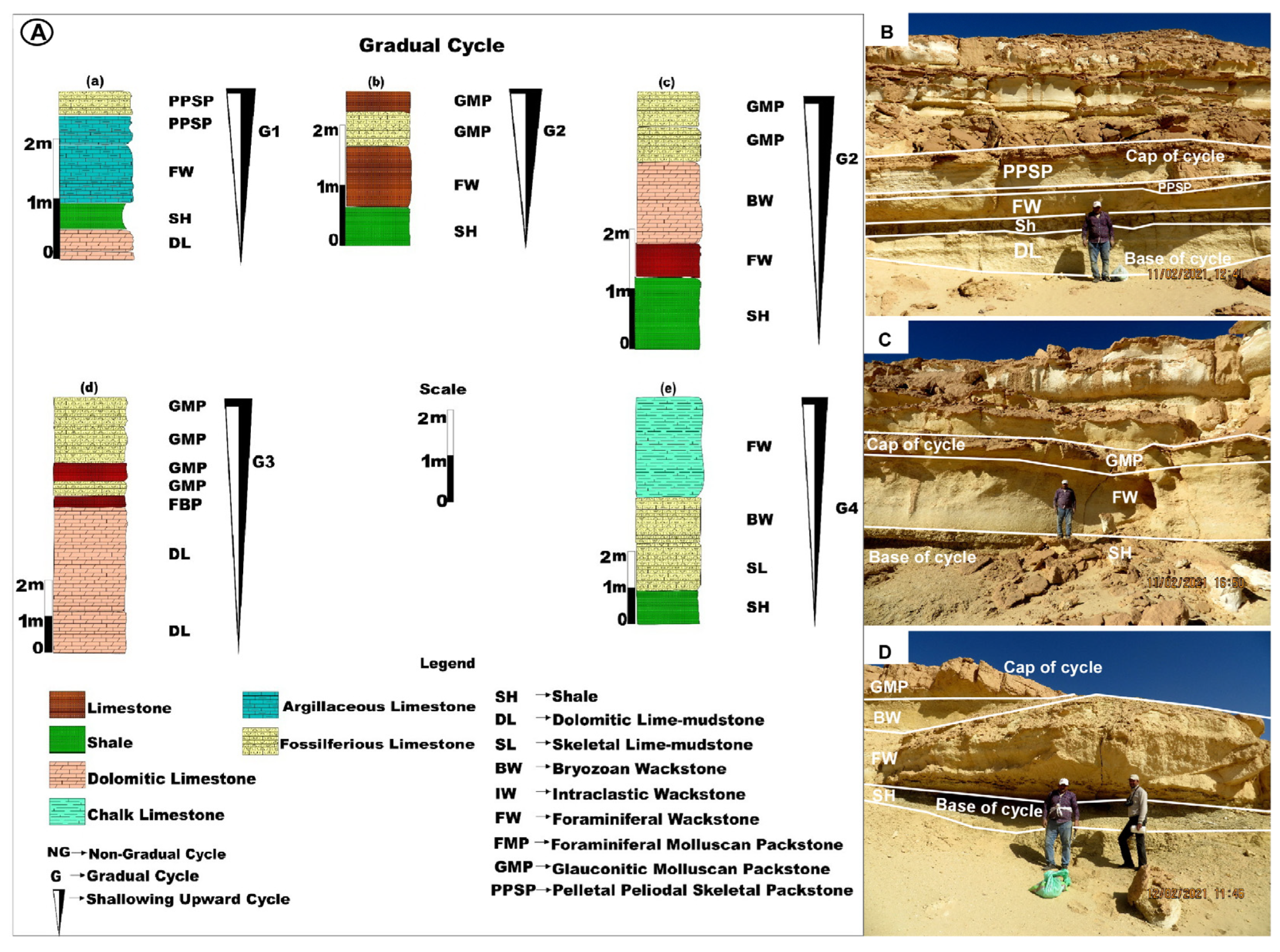
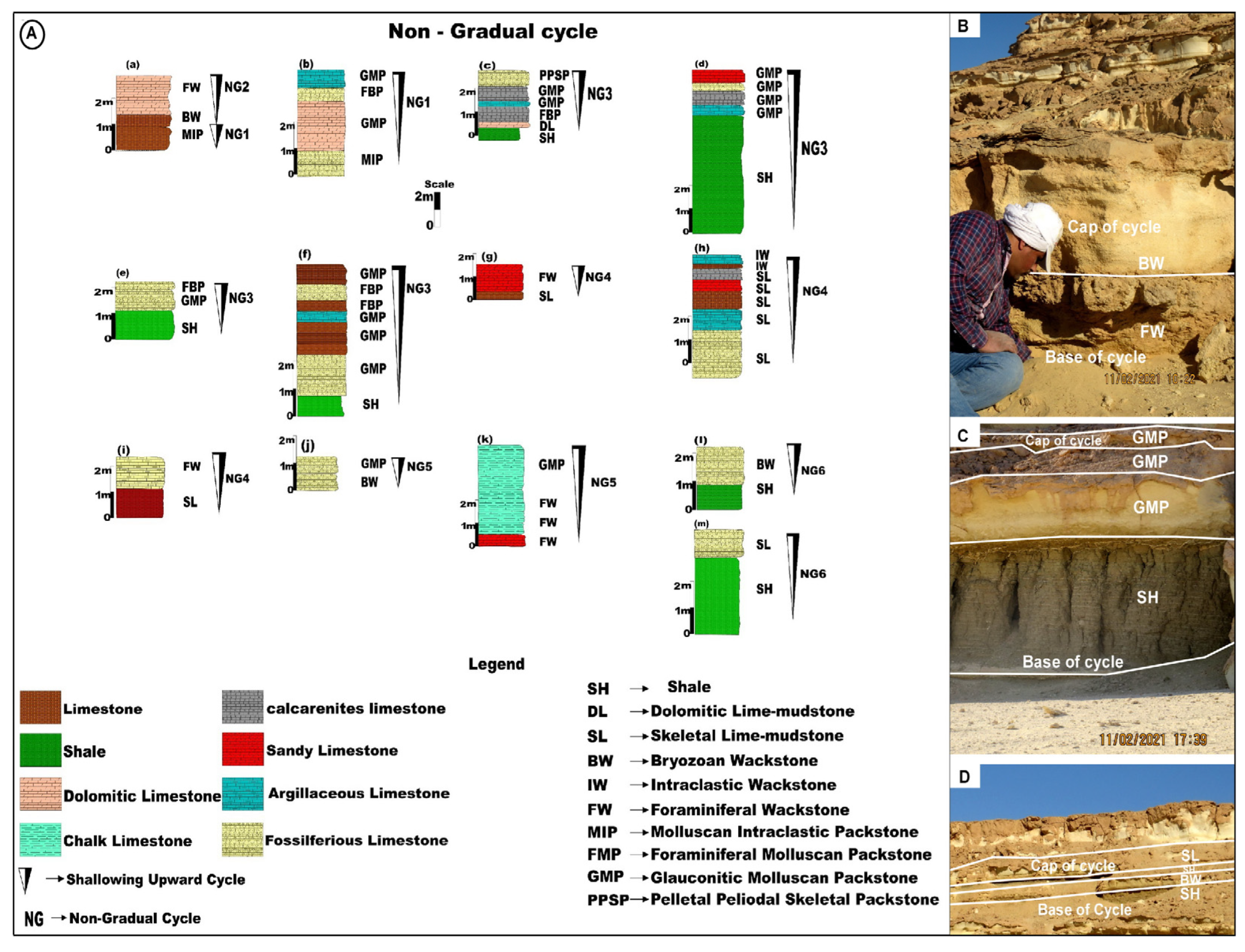
| Series/ Epoch | Stage/ Age | Rock Units | [20] | [14] Siwa Oasis | [23] North-Western Desert (Subsurface) | [24] | [25] Northeastern Libya | [19] | [16] | [17] | Present Study | ||
|---|---|---|---|---|---|---|---|---|---|---|---|---|---|
| Miocene | Middle | Serravallian | Marmarica Fm. | Marmarica Fm. | El-Diffa Plateau mb. | Marmarica Fm. | Marmarica Fm./Gairabub Fm. | Al-gaghboub Fm. | Marmarica Fm. | El-Diffa Plateau mb. | El-Diffa Plateau mb. | Marmarica Fm. | upper mb. |
| Siwa Escarpment mb. | Siwa Escarpment mb. | Siwa Escarpment mb. | middle mb. | ||||||||||
| Langhian | |||||||||||||
| Oasis mb. | Oasis mb. | Oasis mb. | lower mb. | ||||||||||
| Early | Burdigalian | Moghra Fm. | Moghra Fm. | Moghra Fm. | Not-studied | Moghra Fm./Mamoura Fm. | Moghra Fm. | Moghra Fm. | Moghra Fm. | ||||
| Aquitanain | |||||||||||||
| Epoch | Rock Units | Facies Types | Occurrences | Microfacies Description |
|---|---|---|---|---|
| Middle Miocene | Marmarica Fm. | (1) Dolomitic lime mudstone | lower member of G. W. Bahi El-Din and G. El-Najdeen | It is composed of echinod plates (2%), elongated gastropod (1%), shell fragment of pelecypod (1%), red algae (1%), with intraclastic of subrounded lime mudstone (1%) and scattered quartz grains (1%) embedded in a dolomitic lime mud (93%). |
| (2) Skeletal lime mudstone | lower member of G. W. Bahi El-Din and lower, middle, and upper members of G. El-Najdeen | It consists of glauconite patches (2 %), Foraminifera (1%), shell fragment of pelecypod (1%), bryozoa (2%), and scattered quartz grains (3%) embedded in a dark micrite ground mass (92 %). | ||
| (3) Intraclastic wackestone | lower member of G. W. Bahi El-Din | It is composed of intraclastic (10%), glauconite (5%), gastropod (2%), and other skeletal parts and scattered quartz grains (10%) embedded in a micrite ground mass (73%). | ||
| (4) Bryozoan wackestone | lower member of G. W. Bahi El-Din and lower, middle, and upper members of G. El-Najdeen | It consists of bryozoa (15%), echinoderms (10%), mollusca (5%), detrital quartz (5%), foraminifera (2%), ooids (1%), with glauconite patches in a micrite ground mass (63%). | ||
| (5) Foraminiferal wackestone | lower, middle, and upper members of G. W. Bahi El-Din and lower and upper members of G. El-Najdeen | It is made up of skeletal particles and non-carbonate particles. Skeletal particles are represented by foraminifera (10%), echinoderms (10%), molluscan (5%), bryozoa (2%), ostracods (2%), with micritized pellets (2%) intraclastic (2%). Non carbonates are represented by quartz (2–3%), with gypsum replacing lime mudstone which filling most of fossils, all particles are embedded in ground mass micrite (64%). | ||
| (6) Foraminiferal bryozoan packstone | lower and middle members of G. W. Bahi El-Din and lower member of G. El-Najdeen | It consists of skeletal particles and non-carbonate particles. Skeletal particles are bryozoa (20%), echinoderms (10%), foraminifera (10%), molluscan (5%), algae (3%), ostracods (5%), with intraclastic (3%). Non carbonate particles are quartz (3–5%), with gypsum and glauconitic patches replacing lime mudstone which filling most of fossils, these framework components are tightly packed and cemented by a mosaic of sparry calcite (39%). | ||
| (7) Glauconitic molluscan packstone | lower, middle, and upper members of G. W. Bahi El-Din and lower member of G. El-Najdeen | It is composed of skeletal particles and non-carbonate particles. Skeletal particles are molluscan (10–15%), echinoderms (10%), bryozoa (10%), foraminifera (10%), algae (3%), coral (3%), ostracods (2%). Non carbonate particles are quartz (3–4%), with gypsum and glauconitic patches replacing lime mudstone which filling most of fossils, these framework components are tightly packed and cemented by a mosaic of sparry calcite (43%). | ||
| (8) Molluscan intraclastic packstone | lower member of G. W. Bahi El-Din and G. El-Najdeen | It consists mainly of intraclastic (55%), mollusca (15%), echinoderms (5%) and detrital quartz grains (5%). All microfacies embedded in micrite (20%). | ||
| (9) Pelletal peloidal skeletal packstone | lower member of G. W. Bahi El-Din | It consists of peloids (40%), molluscan (5%), ostracod (5%), echinoderms (5%), foraminifera (5%), pellets (2%), detrital quartz (5–6%), all particles embedded in micrite (42%). |
Disclaimer/Publisher’s Note: The statements, opinions and data contained in all publications are solely those of the individual author(s) and contributor(s) and not of MDPI and/or the editor(s). MDPI and/or the editor(s) disclaim responsibility for any injury to people or property resulting from any ideas, methods, instructions or products referred to in the content. |
© 2024 by the authors. Licensee MDPI, Basel, Switzerland. This article is an open access article distributed under the terms and conditions of the Creative Commons Attribution (CC BY) license (https://creativecommons.org/licenses/by/4.0/).
Share and Cite
Khalifa, M.A.; Zaky, A.S.; Jovane, L.; El-Hewy, A.M.; Zahran, E.; Kasem, A.M. The Middle Miocene Microfacies, Cyclicity, and Depositional History: Implications on the Marmarica Formation at the Siwa Oasis, Western Desert (Egypt). Minerals 2024, 14, 73. https://doi.org/10.3390/min14010073
Khalifa MA, Zaky AS, Jovane L, El-Hewy AM, Zahran E, Kasem AM. The Middle Miocene Microfacies, Cyclicity, and Depositional History: Implications on the Marmarica Formation at the Siwa Oasis, Western Desert (Egypt). Minerals. 2024; 14(1):73. https://doi.org/10.3390/min14010073
Chicago/Turabian StyleKhalifa, Mohamed A., Amr S. Zaky, Luigi Jovane, Ahmed M. El-Hewy, Esam Zahran, and Atef M. Kasem. 2024. "The Middle Miocene Microfacies, Cyclicity, and Depositional History: Implications on the Marmarica Formation at the Siwa Oasis, Western Desert (Egypt)" Minerals 14, no. 1: 73. https://doi.org/10.3390/min14010073
APA StyleKhalifa, M. A., Zaky, A. S., Jovane, L., El-Hewy, A. M., Zahran, E., & Kasem, A. M. (2024). The Middle Miocene Microfacies, Cyclicity, and Depositional History: Implications on the Marmarica Formation at the Siwa Oasis, Western Desert (Egypt). Minerals, 14(1), 73. https://doi.org/10.3390/min14010073








